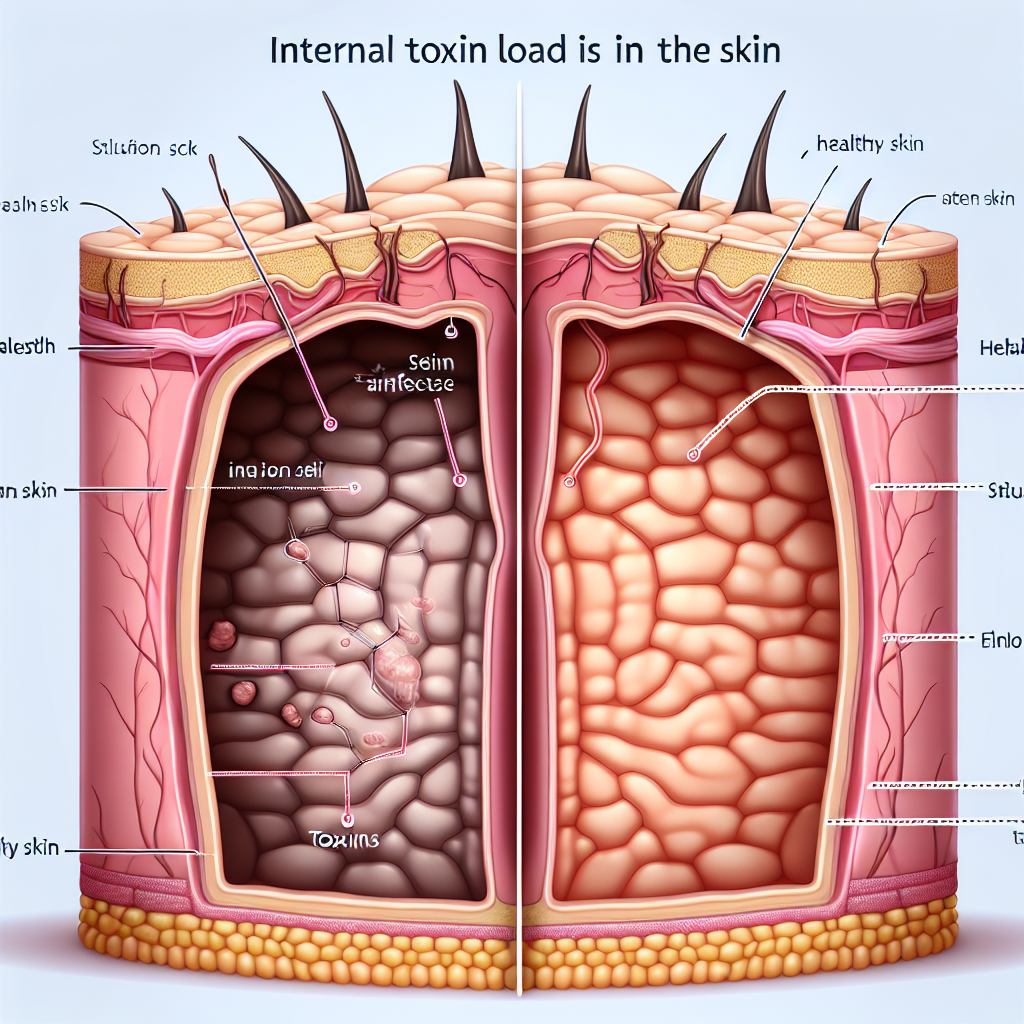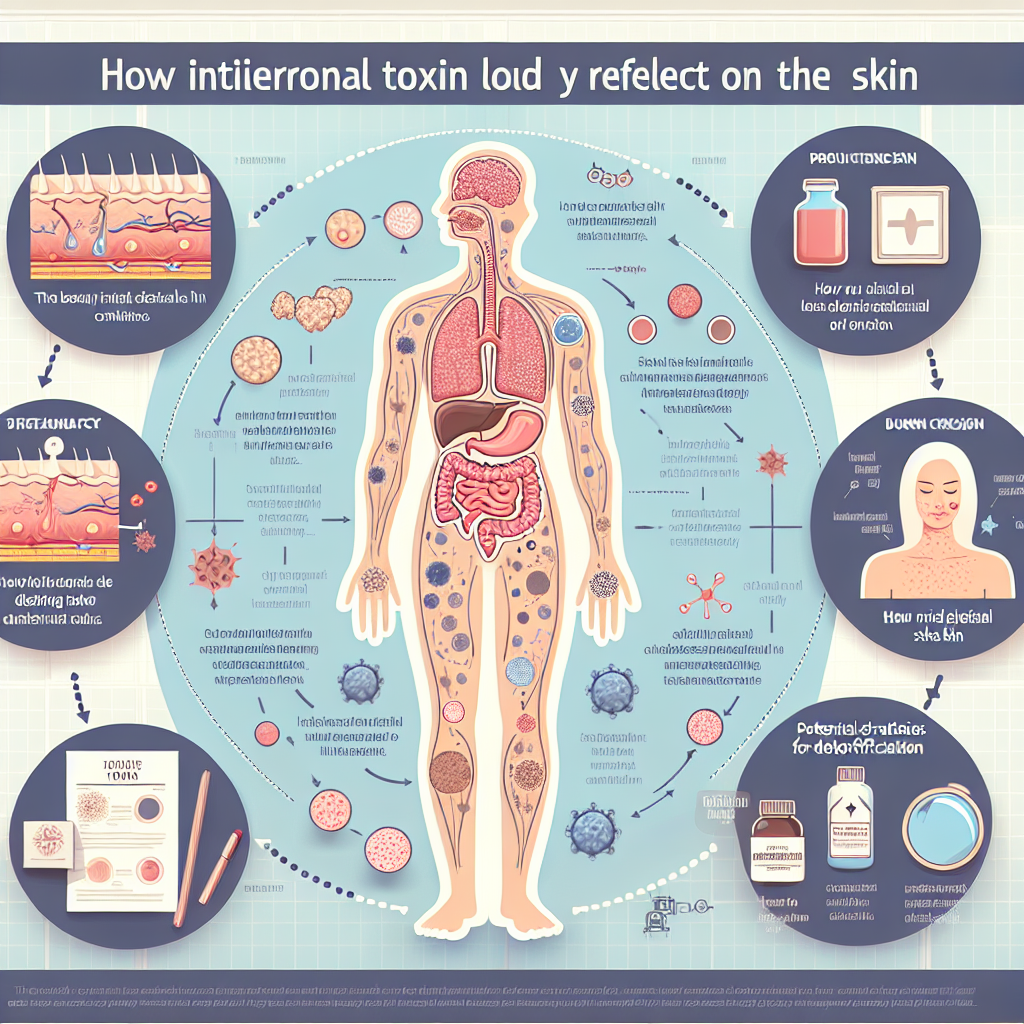How Skin Reflects Internal Toxin Load

Discover how your skin reflects your internal toxin load and learn more about maintaining a healthy, vibrant glow. Visit My Vibrant Vitality today to start your journey towards better skin and overall health.
Understanding the Connection between Skin Health and Internal Toxin Load
The skin, often referred to as the body’s largest organ, is a remarkable entity. It not only serves as a protective barrier against environmental hazards but also acts as a mirror, reflecting our internal health. One of the most intriguing aspects of this reflection is the connection between skin health and internal toxin load. This relationship is a complex one, but understanding it can provide valuable insights into maintaining both skin health and overall well-being.
Toxins are harmful substances that can accumulate in our bodies due to various factors such as poor diet, exposure to environmental pollutants, and inadequate water intake. These toxins can wreak havoc on our internal systems, leading to a range of health issues. However, the body has a natural detoxification system that works to eliminate these toxins. The skin plays a crucial role in this process, acting as an excretory organ to help rid the body of toxins and waste.
When the body’s internal toxin load is high, it can overwhelm the detoxification system, leading to a buildup of toxins. This buildup can manifest itself in various ways on the skin. Common skin problems such as acne, eczema, and psoriasis can often be traced back to an overload of toxins in the body. These conditions are not just superficial skin problems, but rather, they are visible signs of the body’s struggle to manage its internal toxin load.
Moreover, a high toxin load can also lead to premature aging of the skin. Toxins generate free radicals, unstable molecules that can damage cells and contribute to aging and diseases. The skin, being the outermost layer of the body, is particularly vulnerable to this damage. Signs of premature aging such as wrinkles, fine lines, and age spots can be indicative of a high internal toxin load.
However, it’s not all doom and gloom. The good news is that by reducing our internal toxin load, we can improve our skin health and overall well-being. This can be achieved through various means such as maintaining a healthy diet, staying hydrated, getting regular exercise, and avoiding exposure to environmental pollutants. These lifestyle changes can help boost the body’s natural detoxification system, reducing the toxin load and in turn, improving skin health.
In addition, certain skincare practices can also aid in the detoxification process. Regular exfoliation, for instance, can help remove dead skin cells and toxins from the skin’s surface. Similarly, using skincare products with natural ingredients can help nourish the skin and support its role in detoxification.
In conclusion, the connection between skin health and internal toxin load is a testament to the skin’s role as a reflection of our internal health. By understanding this connection, we can take proactive steps to reduce our toxin load and improve our skin health. It’s a holistic approach that not only enhances our appearance but also contributes to our overall well-being. So, the next time you notice a skin issue, remember, it might be your body’s way of signaling a deeper internal problem. Listen to your skin, it’s more than just a surface, it’s a mirror to your internal health.
How Your Skin Reveals the Level of Internal Toxins

The skin, often referred to as the body’s largest organ, serves as a protective barrier against environmental hazards, regulates body temperature, and plays a crucial role in the immune system. However, it also acts as a mirror, reflecting the state of our internal health. One of the most telling signs of internal health is the level of toxins in the body, which can be revealed through the condition of our skin.
Toxins are harmful substances that we encounter daily, from the food we eat to the air we breathe. Our bodies are designed to naturally detoxify and eliminate these toxins through various processes. However, when the toxin load exceeds the body’s detoxification capacity, it can lead to a buildup of toxins, which can manifest in various ways on the skin.
Skin problems such as acne, eczema, psoriasis, and premature aging are often indicators of an internal toxin overload. Acne, for instance, is not just a teenage problem; it can be a sign of a toxic liver. The liver, being the body’s primary detoxification organ, when overwhelmed with toxins, can result in hormonal imbalances leading to acne. Similarly, conditions like eczema and psoriasis are often linked to an overactive immune system, which can be triggered by toxins.
Premature aging is another skin condition that can indicate a high level of internal toxins. Toxins generate free radicals, which cause oxidative stress, leading to the breakdown of collagen and elastin, the proteins responsible for skin’s elasticity and firmness. This breakdown results in wrinkles, fine lines, and sagging skin, signs typically associated with aging.
Moreover, a dull complexion and dark circles under the eyes can also be signs of toxin overload. These conditions are often linked to poor digestion and nutrient absorption, which can be caused by an excess of toxins in the gastrointestinal tract.
It’s important to note that while the skin can reveal the level of internal toxins, it is not the only indicator. Other symptoms such as fatigue, headaches, and digestive issues can also signal a high toxin load. Therefore, it’s crucial to listen to your body and pay attention to any changes or discomforts.
To reduce the toxin load and improve skin health, it’s essential to adopt a holistic approach. This includes a balanced diet rich in antioxidants, regular exercise, adequate hydration, and sufficient sleep. Antioxidants help neutralize free radicals, reducing oxidative stress and its effects on the skin. Regular exercise promotes circulation, aiding in the elimination of toxins through sweat. Adequate hydration supports kidney function, another crucial organ in detoxification, while sufficient sleep allows the body to repair and regenerate.
In conclusion, the skin is a powerful tool in revealing the level of internal toxins in the body. By paying attention to changes in the skin and adopting a holistic approach to health, we can support our body’s detoxification processes, reduce the toxin load, and improve both our skin and overall health. Remember, healthy skin is a reflection of a healthy body.
The Role of Skin in Signaling High Internal Toxin Load
The skin, often referred to as the body’s largest organ, plays a crucial role in signaling high internal toxin load. It is a mirror that reflects our internal health, and its condition can provide valuable insights into the overall state of our body. This article will delve into the intricate relationship between our skin and internal toxin load, shedding light on how our skin can act as a barometer for our internal health.
Toxins are harmful substances that can accumulate in our bodies due to various factors such as poor diet, exposure to environmental pollutants, and lack of exercise. These toxins can wreak havoc on our health, leading to a myriad of health issues ranging from minor ailments like headaches and fatigue to serious conditions like heart disease and cancer. However, our bodies are equipped with a sophisticated detoxification system that works tirelessly to eliminate these toxins and maintain our health. The skin, being a part of this system, plays a pivotal role in this process.
The skin acts as a protective barrier, shielding our internal organs from harmful substances. It also serves as an excretory organ, helping to eliminate toxins from the body through sweat. When the body’s internal toxin load is high, the skin works overtime to expel these harmful substances. This increased activity can manifest in various skin conditions such as acne, rashes, eczema, and premature aging. Therefore, these skin issues can be seen as the body’s cry for help, signaling an overload of toxins that the body is struggling to eliminate.
Moreover, the skin’s appearance can also provide clues about the body’s internal toxin load. A dull, lifeless complexion, for instance, can indicate a high toxin load. This is because toxins can interfere with the skin’s ability to regenerate and repair itself, leading to a lackluster appearance. Similarly, dark circles under the eyes can be a sign of toxin overload. These are caused by the accumulation of toxins in the delicate skin under the eyes, which can lead to inflammation and blood vessel dilation, resulting in a darkened appearance.
In addition to these visible signs, the skin can also signal high internal toxin load through its texture. A rough, dry skin texture can be a sign of dehydration, which can occur when the body is overloaded with toxins. This is because toxins can disrupt the body’s water balance, leading to dehydration and subsequently, dry skin. On the other hand, oily skin can indicate an overactive sebaceous gland, which can be a response to high toxin levels. The body may increase oil production in an attempt to trap and eliminate toxins through the skin.
In conclusion, the skin plays a vital role in signaling high internal toxin load. Its condition, appearance, and texture can provide valuable insights into the body’s internal health, acting as a barometer for our overall wellbeing. Therefore, it is essential to pay attention to these signs and take appropriate measures to reduce our internal toxin load. This can be achieved through a healthy diet, regular exercise, adequate hydration, and proper skincare. By taking care of our skin, we are not only enhancing our external appearance but also promoting our internal health.